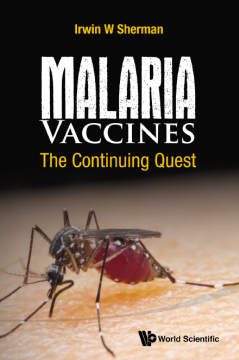
Additional Information
Book Details
Abstract
In 2013, 200 million people were infected with malaria, resulting in over 584,000 deaths, with the potential to affect over half the world's population. Such is the widespread nature of malaria that it is increasingly believed only a vaccine will lead to its eradication.Although the first attempt at a vaccine was made a century ago, it is only in the last 30 years that real progress in testing has been made, in the hope of discovering a molecule that can provide long-lasting protection against the disease. In July 2015, GlaxoSmithKline (GSK) announced that after 30 years of research it had received the green light from the European Medicines Agency for the world's first malaria vaccine, RTS, S, for use in African children aged 6 weeks to 17 months.This book chronicles the development of RTS, S — done in collaboration with the Walter Reed Army Institute for Research, the PATH Malaria Vaccine Initiative (MVI) and funded in part by the Bill and Melinda Gates Foundation — as well as previous candidate vaccines. It also focusses on the continuing quest to find more effective vaccines against this continuing health crisis. Finally, it provides an easily understood background on recombinant DNA and monoclonal antibodies and places them in perspective to their contributions to malaria vaccine development.This book serves as a convenient and easily accessible source of information for students, teachers, microbiologists, parasitologists, physicians, clinicians and research funders.
Table of Contents
| Section Title | Page | Action | Price |
|---|---|---|---|
| Contents | v | ||
| Preface | vii | ||
| Chapter 1. The Three Lives of the Malaria Parasite | 1 | ||
| i. Laveran’s Animalcule | 2 | ||
| ii. Miasma to Mosquito | 6 | ||
| iii. A Matter of Priority: Ross vs. Grassi | 13 | ||
| iv. A Hidden Life Revealed | 18 | ||
| v. The Sickness | 22 | ||
| Chapter 2. A Personal Scientific Odyssey | 25 | ||
| i. Early Years | 25 | ||
| ii. Graduate Studies | 30 | ||
| iii. The Rockefeller Institute and Post-doctoral Research | 37 | ||
| iv. Research at the University of California | 48 | ||
| v. Studies of Malaria Antigens | 57 | ||
| Chapter 3. Taming the Malaria Parasite | 63 | ||
| Chapter 4. The Quest for a Blood Stage Vaccine Begins | 67 | ||
| Chapter 5. Malaria Vaccines and Malfeasance | 77 | ||
| Chapter 6. Dreaming of a Nobel Prize | 93 | ||
| Chapter 7. Molecular Biology Assists in Vaccine Development | 99 | ||
| Chapter 8. Developing Vaccines against Blood Stages | 115 | ||
| i. Duffy Binding Proteins (DBPs) | 115 | ||
| ii. Erythrocyte Binding Antigen 175 (EBA-175) | 122 | ||
| iii. Monoclonal Antibodies and Merozoite Surface Protein (MSP)-1 | 125 | ||
| a. Discovery of Monoclonal Antibodies | 125 | ||
| b. The Path to MSP-1 | 128 | ||
| iv. AMA-1 | 135 | ||
| v. PfRH5 | 142 | ||
| vi. A Failed Promise, SPf66 | 143 | ||
| vii. MSP-3 | 145 | ||
| viii. GMZ2 | 148 | ||
| Chapter 9. PfEMP1, pfalhesin, and DBR | 151 | ||
| i Knobs and Adhesion | 152 | ||
| ii SICA and Antigenic Variation | 153 | ||
| iii. Antigenic Variation and P. falciparum Erythrocyte Membrane Protein 1 (PfEMP1) | 156 | ||
| iv. PfEMP1 and Placental Adhesion | 161 | ||
| v. Pfalhesin and DBR | 164 | ||
| Chapter 10. Vaccines to Halt Transmission | 173 | ||
| i. Mutualistic or Cooperative TBVs | 175 | ||
| ii. The Nature of Transmission-Blocking Immunity | 180 | ||
| iii. Discovering the Antigens for a TBV | 181 | ||
| iv. To Make a TBV | 183 | ||
| Chapter 11. Sporozoite Invasion and the Path to RTS, S | 189 | ||
| i. Vaccination with Irradiated Sporozoites | 190 | ||
| ii. A Sporozoite Antigen Identified | 198 | ||
| iii. WRAIR and RTS, S | 202 | ||
| iv. RTS, S | 209 | ||
| Chapter 12. Attenuated Plasmodial Vaccines | 215 | ||
| i. X-Irradiated Sporozoites of Plasmodium falciparum, PfSPZ | 215 | ||
| ii. Mind the Genetically Attenuated Parasites (GAPs) | 219 | ||
| iii. A Live Blood Stage Vaccine? | 222 | ||
| Chapter 13. Viruses and Plasmodial Vaccines | 225 | ||
| Chapter 14. Why the Quest Continues | 231 | ||
| References | 237 | ||
| Index | 259 |
